Alfa Romeo 147 2010 Owner handbook (in English)
Manufacturer: ALFA ROMEO, Model Year: 2010, Model line: 147, Model: Alfa Romeo 147 2010Pages: 291, PDF Size: 5.52 MB
Page 31 of 291
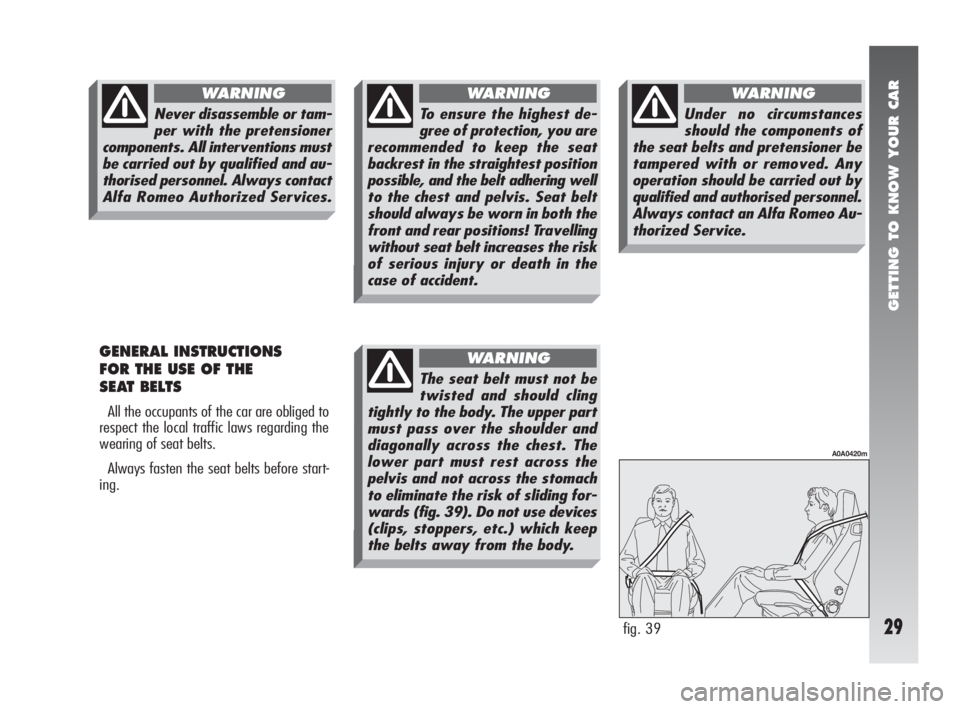
GETTING TO KNOW YOUR CAR
29
GENERAL INSTRUCTIONS
FOR THE USE OF THE
SEAT BELTS
All the occupants of the car are obliged to
respect the local traffic laws regarding the
wearing of seat belts.
Always fasten the seat belts before start-
ing.
fig. 39
A0A0420m
Never disassemble or tam-
per with the pretensioner
components. All interventions must
be carried out by qualified and au-
thorised personnel. Always contact
Alfa Romeo Authorized Services.
WARNING
To ensure the highest de-
gree of protection, you are
recommended to keep the seat
backrest in the straightest position
possible, and the belt adhering well
to the chest and pelvis. Seat belt
should always be worn in both the
front and rear positions! Travelling
without seat belt increases the risk
of serious injury or death in the
case of accident.
WARNING
The seat belt must not be
twisted and should cling
tightly to the body. The upper part
must pass over the shoulder and
diagonally across the chest. The
lower part must rest across the
pelvis and not across the stomach
to eliminate the risk of sliding for-
wards (fig. 39). Do not use devices
(clips, stoppers, etc.) which keep
the belts away from the body.
WARNING
Under no circumstances
should the components of
the seat belts and pretensioner be
tampered with or removed. Any
operation should be carried out by
qualified and authorised personnel.
Always contact an Alfa Romeo Au-
thorized Service.
WARNING
Page 32 of 291
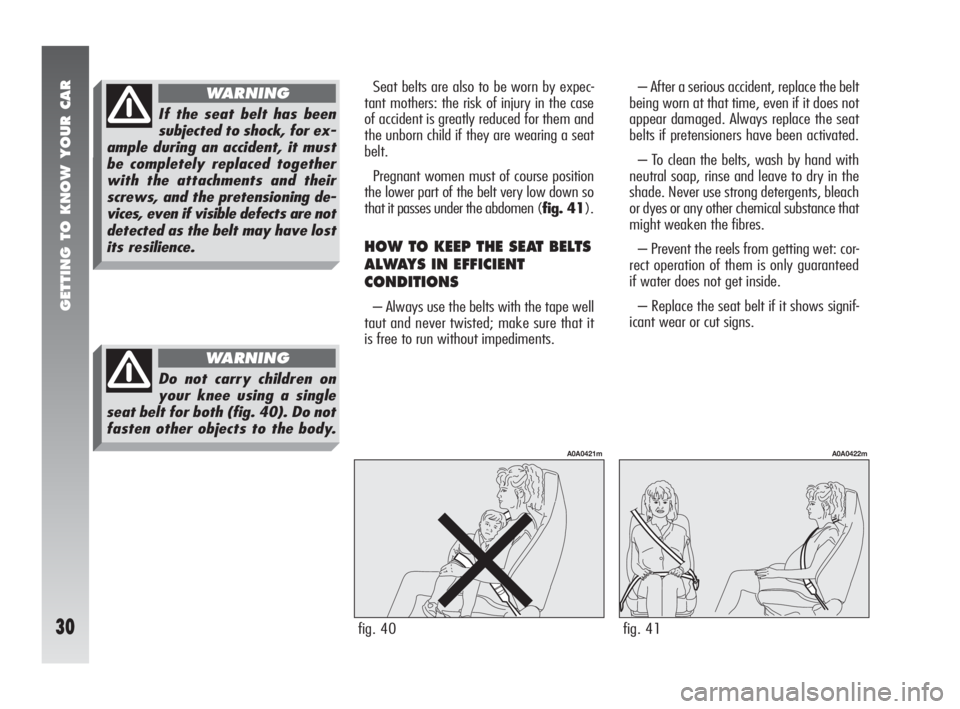
GETTING TO KNOW YOUR CAR
30
Seat belts are also to be worn by expec-
tant mothers: the risk of injury in the case
of accident is greatly reduced for them and
the unborn child if they are wearing a seat
belt.
Pregnant women must of course position
the lower part of the belt very low down so
that it passes under the abdomen (fig. 41).
HOW TO KEEP THE SEAT BELTS
ALWAYS IN EFFICIENT
CONDITIONS
– Always use the belts with the tape well
taut and never twisted; make sure that it
is free to run without impediments.– After a serious accident, replace the belt
being worn at that time, even if it does not
appear damaged. Always replace the seat
belts if pretensioners have been activated.
– To clean the belts, wash by hand with
neutral soap, rinse and leave to dry in the
shade. Never use strong detergents, bleach
or dyes or any other chemical substance that
might weaken the fibres.
– Prevent the reels from getting wet: cor-
rect operation of them is only guaranteed
if water does not get inside.
– Replace the seat belt if it shows signif-
icant wear or cut signs.
fig. 40
A0A0421m
fig. 41
A0A0422m
Do not carry children on
your knee using a single
seat belt for both (fig. 40). Do not
fasten other objects to the body.
WARNING
If the seat belt has been
subjected to shock, for ex-
ample during an accident, it must
be completely replaced together
with the attachments and their
screws, and the pretensioning de-
vices, even if visible defects are not
detected as the belt may have lost
its resilience.
WARNING
Page 33 of 291
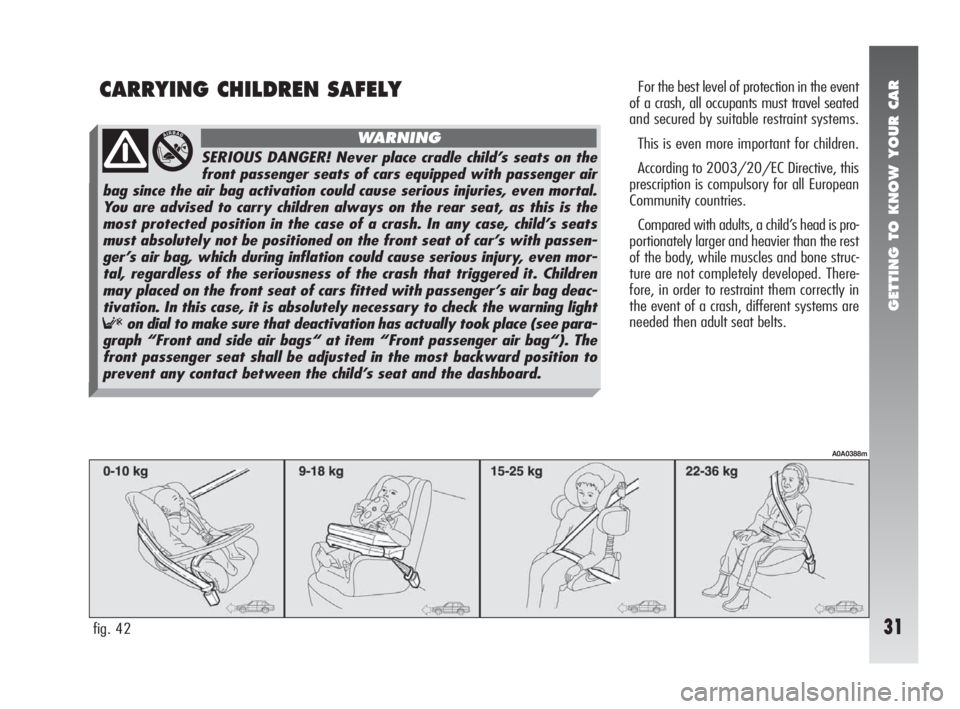
GETTING TO KNOW YOUR CAR
31
CARRYING CHILDREN SAFELYFor the best level of protection in the event
of a crash, all occupants must travel seated
and secured by suitable restraint systems.
This is even more important for children.
According to 2003/20/EC Directive, this
prescription is compulsory for all European
Community countries.
Compared with adults, a child’s head is pro-
portionately larger and heavier than the rest
of the body, while muscles and bone struc-
ture are not completely developed. There-
fore, in order to restraint them correctly in
the event of a crash, different systems are
needed then adult seat belts.
fig. 42
A0A0388m
SERIOUS DANGER! Never place cradle child’s seats on the
front passenger seats of cars equipped with passenger air
bag since the air bag activation could cause serious injuries, even mortal.
You are advised to carry children always on the rear seat, as this is the
most protected position in the case of a crash. In any case, child’s seats
must absolutely not be positioned on the front seat of car’s with passen-
ger’s air bag, which during inflation could cause serious injury, even mor-
tal, regardless of the seriousness of the crash that triggered it. Children
may placed on the front seat of cars fitted with passenger’s air bag deac-
tivation. In this case, it is absolutely necessary to check the warning light
Fon dial to make sure that deactivation has actually took place (see para-
graph “Front and side air bags“ at item “Front passenger air bag“). The
front passenger seat shall be adjusted in the most backward position to
prevent any contact between the child’s seat and the dashboard.
WARNING
Page 34 of 291
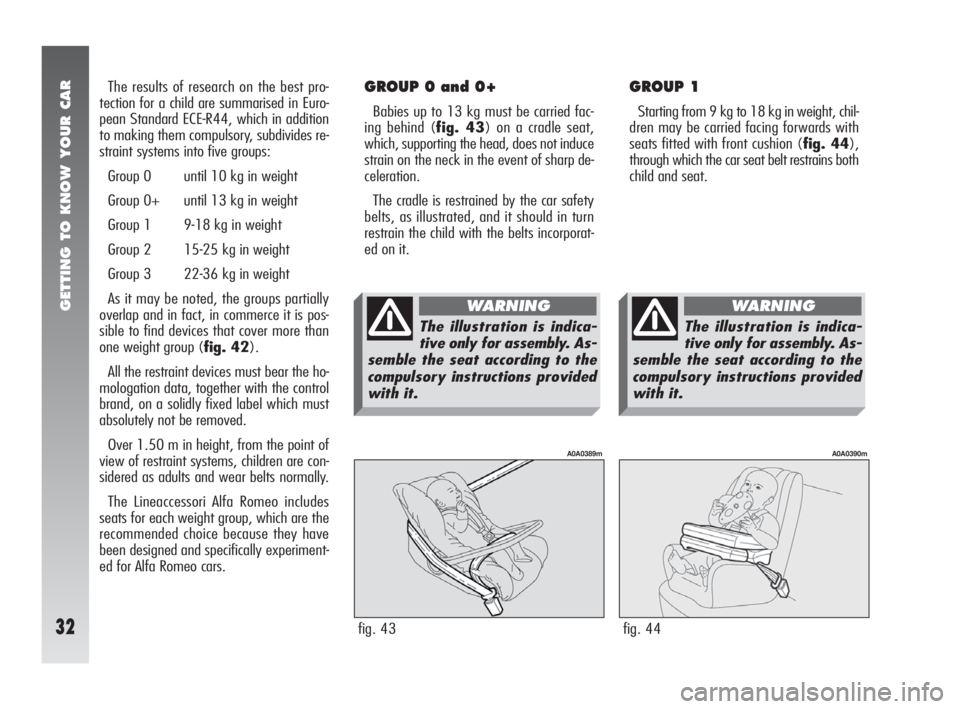
GETTING TO KNOW YOUR CAR
32
GROUP 1
Starting from 9 kg to 18 kg in weight, chil-
dren may be carried facing forwards with
seats fitted with front cushion (fig. 44),
through which the car seat belt restrains both
child and seat. The results of research on the best pro-
tection for a child are summarised in Euro-
pean Standard ECE-R44, which in addition
to making them compulsory, subdivides re-
straint systems into five groups:
Group 0 until 10 kg in weight
Group 0+ until 13 kg in weight
Group 1 9-18 kg in weight
Group 2 15-25 kg in weight
Group 3 22-36 kg in weight
As it may be noted, the groups partially
overlap and in fact, in commerce it is pos-
sible to find devices that cover more than
one weight group (fig. 42).
All the restraint devices must bear the ho-
mologation data, together with the control
brand, on a solidly fixed label which must
absolutely not be removed.
Over 1.50 m in height, from the point of
view of restraint systems, children are con-
sidered as adults and wear belts normally.
The Lineaccessori Alfa Romeo includes
seats for each weight group, which are the
recommended choice because they have
been designed and specifically experiment-
ed for Alfa Romeo cars.
GROUP 0 and 0+
Babies up to 13 kg must be carried fac-
ing behind (fig. 43) on a cradle seat,
which, supporting the head, does not induce
strain on the neck in the event of sharp de-
celeration.
The cradle is restrained by the car safety
belts, as illustrated, and it should in turn
restrain the child with the belts incorporat-
ed on it.
fig. 43
A0A0389m
fig. 44
A0A0390m
The illustration is indica-
tive only for assembly. As-
semble the seat according to the
compulsory instructions provided
with it.
WARNING
The illustration is indica-
tive only for assembly. As-
semble the seat according to the
compulsory instructions provided
with it.
WARNING
Page 35 of 291
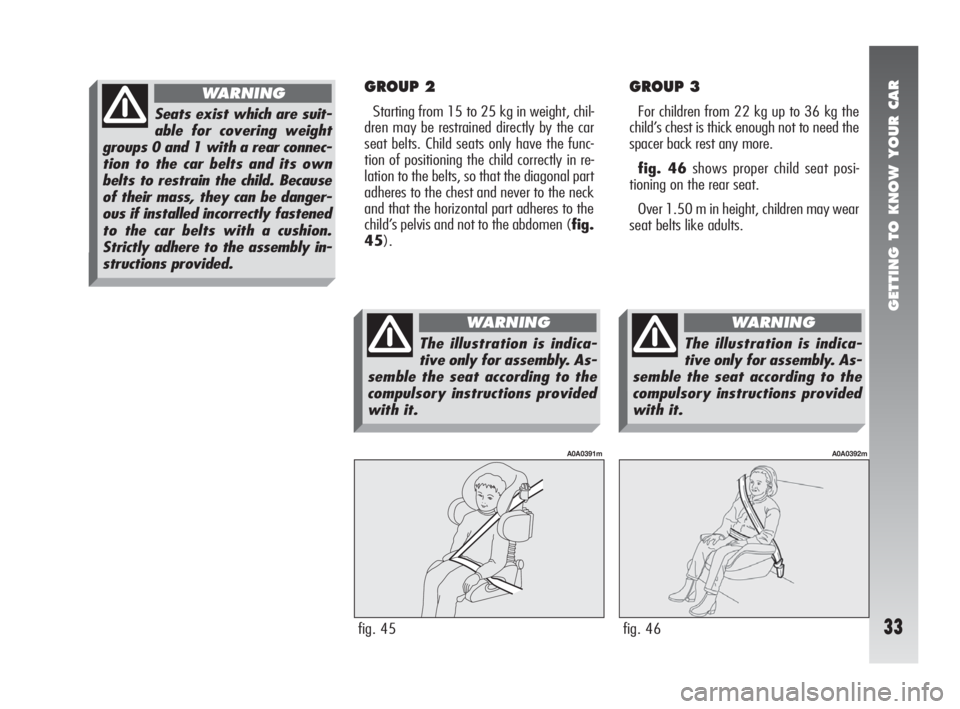
GETTING TO KNOW YOUR CAR
33
GROUP 2
Starting from 15 to 25 kg in weight, chil-
dren may be restrained directly by the car
seat belts. Child seats only have the func-
tion of positioning the child correctly in re-
lation to the belts, so that the diagonal part
adheres to the chest and never to the neck
and that the horizontal part adheres to the
child’s pelvis and not to the abdomen (fig.
45).
GROUP 3
For children from 22 kg up to 36 kg the
child’s chest is thick enough not to need the
spacer back rest any more.
fig. 46shows proper child seat posi-
tioning on the rear seat.
Over 1.50 m in height, children may wear
seat belts like adults.
fig. 45
A0A0391m
fig. 46
A0A0392m
The illustration is indica-
tive only for assembly. As-
semble the seat according to the
compulsory instructions provided
with it.
WARNING
The illustration is indica-
tive only for assembly. As-
semble the seat according to the
compulsory instructions provided
with it.
WARNING
Seats exist which are suit-
able for covering weight
groups 0 and 1 with a rear connec-
tion to the car belts and its own
belts to restrain the child. Because
of their mass, they can be danger-
ous if installed incorrectly fastened
to the car belts with a cushion.
Strictly adhere to the assembly in-
structions provided.
WARNING
Page 36 of 291
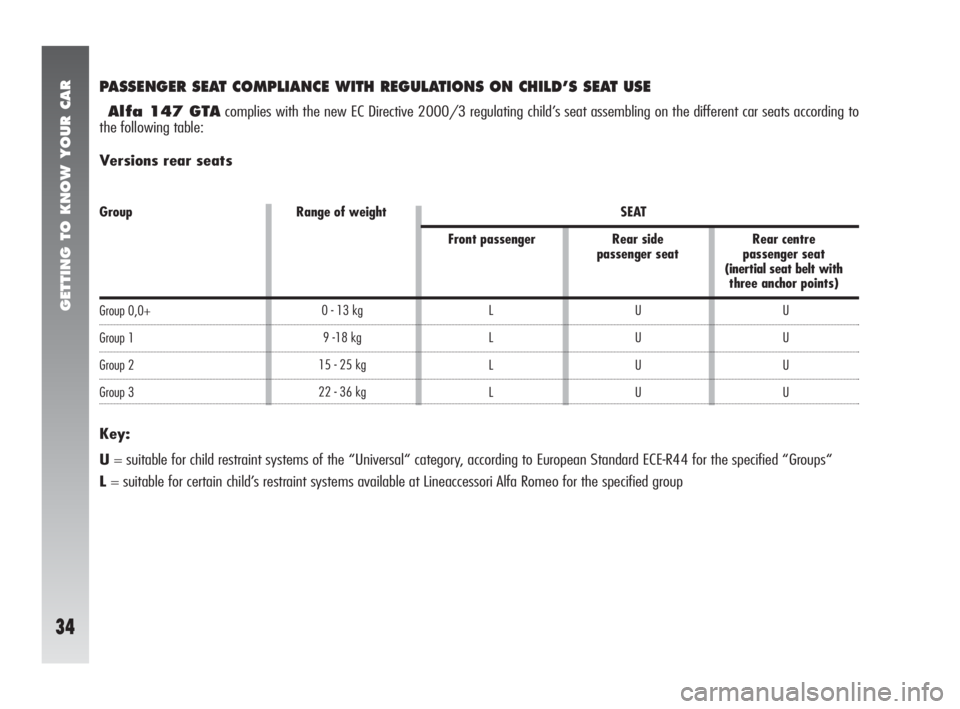
GETTING TO KNOW YOUR CAR
34
PASSENGER SEAT COMPLIANCE WITH REGULATIONS ON CHILD’S SEAT USE
Alfa 147 GTAcomplies with the new EC Directive 2000/3 regulating child’s seat assembling on the different car seats according to
the following table:
Versions rear seats
U
U
U
U U
U
U
U L
L
L
L 0 - 13 kg
9 -18 kg
15 - 25 kg
22 - 36 kg
Group Range of weight SEAT
Front passenger Rear side Rear centre
passenger seat passenger seat
(inertial seat belt with
three anchor points)
Group 0,0+
Group 1
Group 2
Group 3
Key:
U= suitable for child restraint systems of the “Universal“ category, according to European Standard ECE-R44 for the specified “Groups“
L= suitable for certain child’s restraint systems available at Lineaccessori Alfa Romeo for the specified group
Page 37 of 291
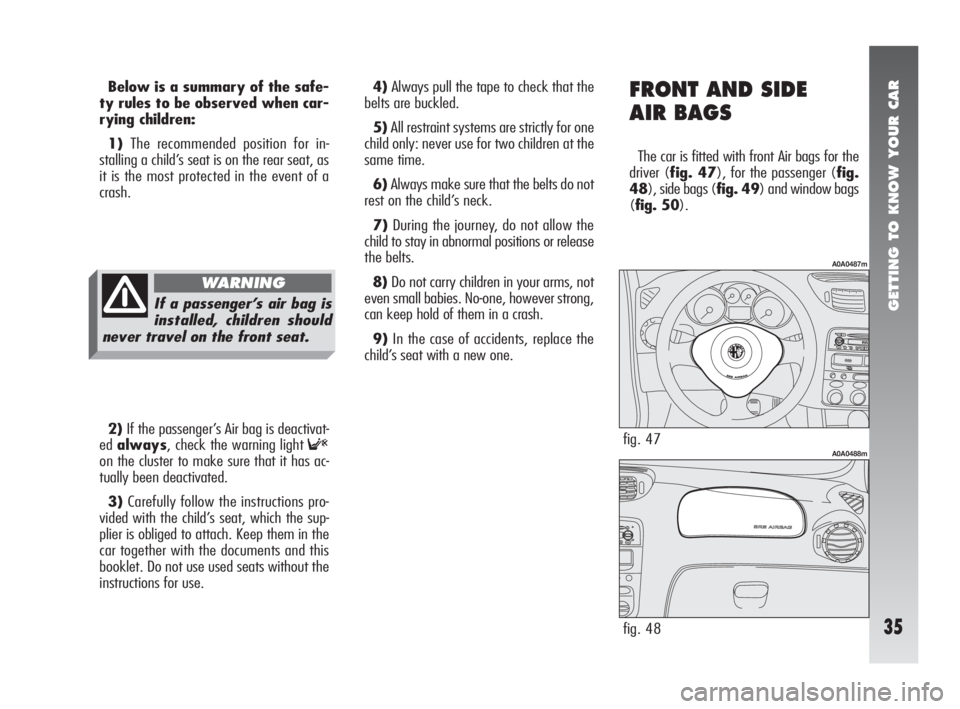
GETTING TO KNOW YOUR CAR
35
fig. 47
A0A0487m
fig. 48
A0A0488m
Below is a summary of the safe-
ty rules to be observed when car-
rying children:
1)The recommended position for in-
stalling a child’s seat is on the rear seat, as
it is the most protected in the event of a
crash.
2)If the passenger’s Air bag is deactivat-
edalways, check the warning light
F
on the cluster to make sure that it has ac-
tually been deactivated.
3)Carefully follow the instructions pro-
vided with the child’s seat, which the sup-
plier is obliged to attach. Keep them in the
car together with the documents and this
booklet. Do not use used seats without the
instructions for use.4)Always pull the tape to check that the
belts are buckled.
5)All restraint systems are strictly for one
child only: never use for two children at the
same time.
6)Always make sure that the belts do not
rest on the child’s neck.
7)During the journey, do not allow the
child to stay in abnormal positions or release
the belts.
8)Do not carry children in your arms, not
even small babies. No-one, however strong,
can keep hold of them in a crash.
9)In the case of accidents, replace the
child’s seat with a new one.
FRONT AND SIDE
AIR BAGS
The car is fitted with front Air bags for the
driver (fig. 47), for the passenger (fig.
48), side bags (fig. 49) and window bags
(fig. 50).
If a passenger’s air bag is
installed, children should
never travel on the front seat.
WARNING
Page 38 of 291
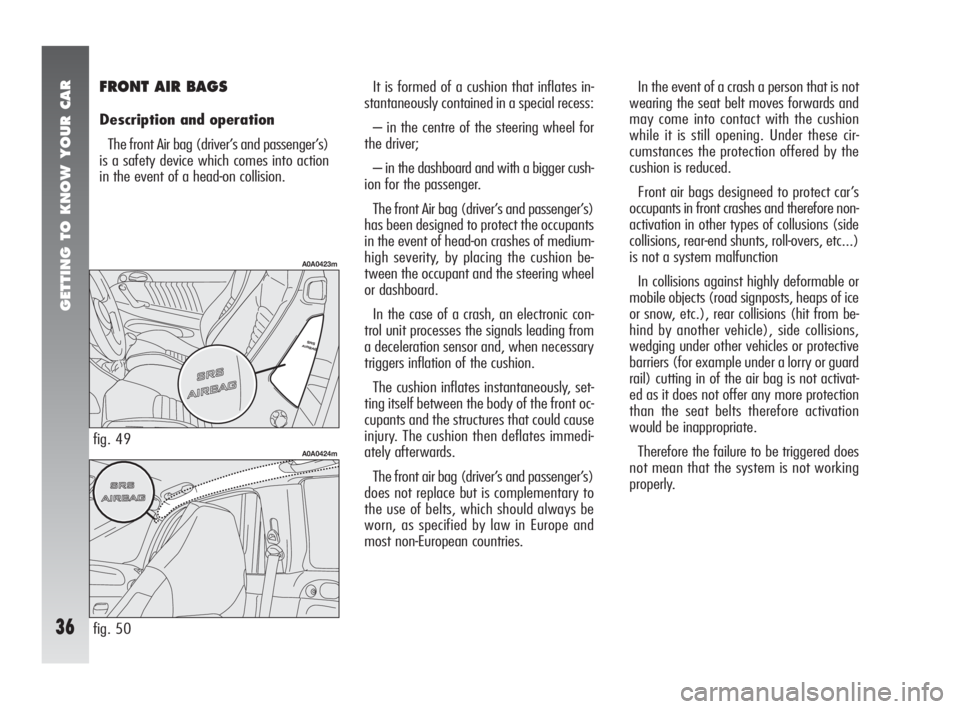
GETTING TO KNOW YOUR CAR
36
It is formed of a cushion that inflates in-
stantaneously contained in a special recess:
– in the centre of the steering wheel for
the driver;
– in the dashboard and with a bigger cush-
ion for the passenger.
The front Air bag (driver’s and passenger’s)
has been designed to protect the occupants
in the event of head-on crashes of medium-
high severity, by placing the cushion be-
tween the occupant and the steering wheel
or dashboard.
In the case of a crash, an electronic con-
trol unit processes the signals leading from
a deceleration sensor and, when necessary
triggers inflation of the cushion.
The cushion inflates instantaneously, set-
ting itself between the body of the front oc-
cupants and the structures that could cause
injury. The cushion then deflates immedi-
ately afterwards.
The front air bag (driver’s and passenger’s)
does not replace but is complementary to
the use of belts, which should always be
worn, as specified by law in Europe and
most non-European countries.In the event of a crash a person that is not
wearing the seat belt moves forwards and
may come into contact with the cushion
while it is still opening. Under these cir-
cumstances the protection offered by the
cushion is reduced.
Front air bags designeed to protect car’s
occupants in front crashes and therefore non-
activation in other types of collusions (side
collisions, rear-end shunts, roll-overs, etc...)
is not a system malfunction
In collisions against highly deformable or
mobile objects (road signposts, heaps of ice
or snow, etc.), rear collisions (hit from be-
hind by another vehicle), side collisions,
wedging under other vehicles or protective
barriers (for example under a lorry or guard
rail) cutting in of the air bag is not activat-
ed as it does not offer any more protection
than the seat belts therefore activation
would be inappropriate.
Therefore the failure to be triggered does
not mean that the system is not working
properly.FRONT AIR BAGS
Description and operation
The front Air bag (driver’s and passenger’s)
is a safety device which comes into action
in the event of a head-on collision.
fig. 49
A0A0423m
fig. 50
A0A0424m
Page 39 of 291
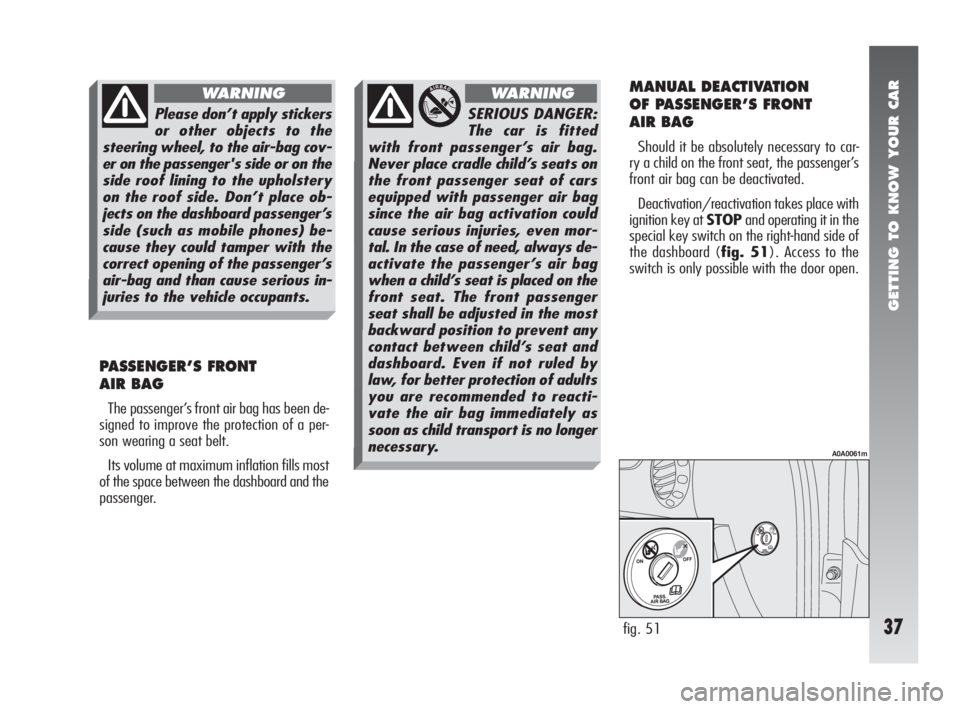
GETTING TO KNOW YOUR CAR
37
PASSENGER’S FRONT
AIR BAG
The passenger’s front air bag has been de-
signed to improve the protection of a per-
son wearing a seat belt.
Its volume at maximum inflation fills most
of the space between the dashboard and the
passenger.
MANUAL DEACTIVATION
OF PASSENGER’S FRONT
AIR BAG
Should it be absolutely necessary to car-
ry a child on the front seat, the passenger’s
front air bag can be deactivated.
Deactivation/reactivation takes place with
ignition key at STOPand operating it in the
special key switch on the right-hand side of
the dashboard (fig. 51). Access to the
switch is only possible with the door open.
fig. 51
A0A0061m
SERIOUS DANGER:
The car is fitted
with front passenger’s air bag.
Never place cradle child’s seats on
the front passenger seat of cars
equipped with passenger air bag
since the air bag activation could
cause serious injuries, even mor-
tal. In the case of need, always de-
activate the passenger’s air bag
when a child’s seat is placed on the
front seat. The front passenger
seat shall be adjusted in the most
backward position to prevent any
contact between child’s seat and
dashboard. Even if not ruled by
law, for better protection of adults
you are recommended to reacti-
vate the air bag immediately as
soon as child transport is no longer
necessary.
WARNING
Please don’t apply stickers
or other objects to the
steering wheel, to the air-bag cov-
er on the passenger's side or on the
side roof lining to the upholstery
on the roof side. Don’t place ob-
jects on the dashboard passenger’s
side (such as mobile phones) be-
cause they could tamper with the
correct opening of the passenger’s
air-bag and than cause serious in-
juries to the vehicle occupants.
WARNING
Page 40 of 291
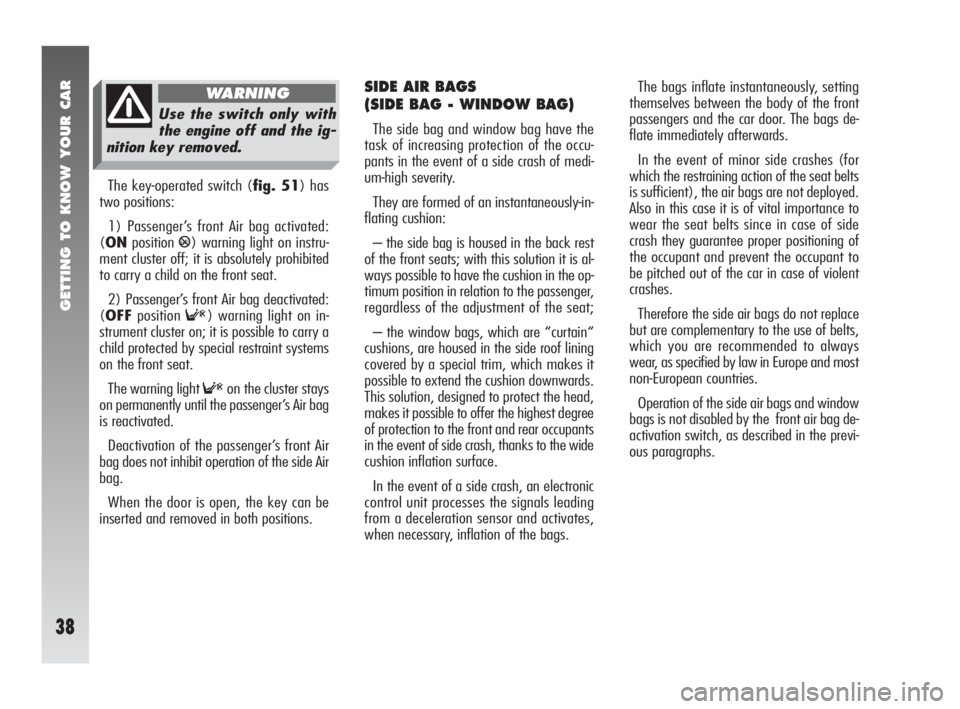
GETTING TO KNOW YOUR CAR
38
The key-operated switch (fig. 51) has
two positions:
1) Passenger’s front Air bag activated:
(ONposition
P) warning light on instru-
ment cluster off; it is absolutely prohibited
to carry a child on the front seat.
2) Passenger’s front Air bag deactivated:
(OFFposition
F) warning light on in-
strument cluster on; it is possible to carry a
child protected by special restraint systems
on the front seat.
The warning light
Fon the cluster stays
on permanently until the passenger’s Air bag
is reactivated.
Deactivation of the passenger’s front Air
bag does not inhibit operation of the side Air
bag.
When the door is open, the key can be
inserted and removed in both positions.
SIDE AIR BAGS
(SIDE BAG - WINDOW BAG)
The side bag and window bag have the
task of increasing protection of the occu-
pants in the event of a side crash of medi-
um-high severity.
They are formed of an instantaneously-in-
flating cushion:
– the side bag is housed in the back rest
of the front seats; with this solution it is al-
ways possible to have the cushion in the op-
timum position in relation to the passenger,
regardless of the adjustment of the seat;
– the window bags, which are “curtain“
cushions, are housed in the side roof lining
covered by a special trim, which makes it
possible to extend the cushion downwards.
This solution, designed to protect the head,
makes it possible to offer the highest degree
of protection to the front and rear occupants
in the event of side crash, thanks to the wide
cushion inflation surface.
In the event of a side crash, an electronic
control unit processes the signals leading
from a deceleration sensor and activates,
when necessary, inflation of the bags.The bags inflate instantaneously, setting
themselves between the body of the front
passengers and the car door. The bags de-
flate immediately afterwards.
In the event of minor side crashes (for
which the restraining action of the seat belts
is sufficient), the air bags are not deployed.
Also in this case it is of vital importance to
wear the seat belts since in case of side
crash they guarantee proper positioning of
the occupant and prevent the occupant to
be pitched out of the car in case of violent
crashes.
Therefore the side air bags do not replace
but are complementary to the use of belts,
which you are recommended to always
wear, as specified by law in Europe and most
non-European countries.
Operation of the side air bags and window
bags is not disabled by the front air bag de-
activation switch, as described in the previ-
ous paragraphs.
Use the switch only with
the engine off and the ig-
nition key removed.
WARNING